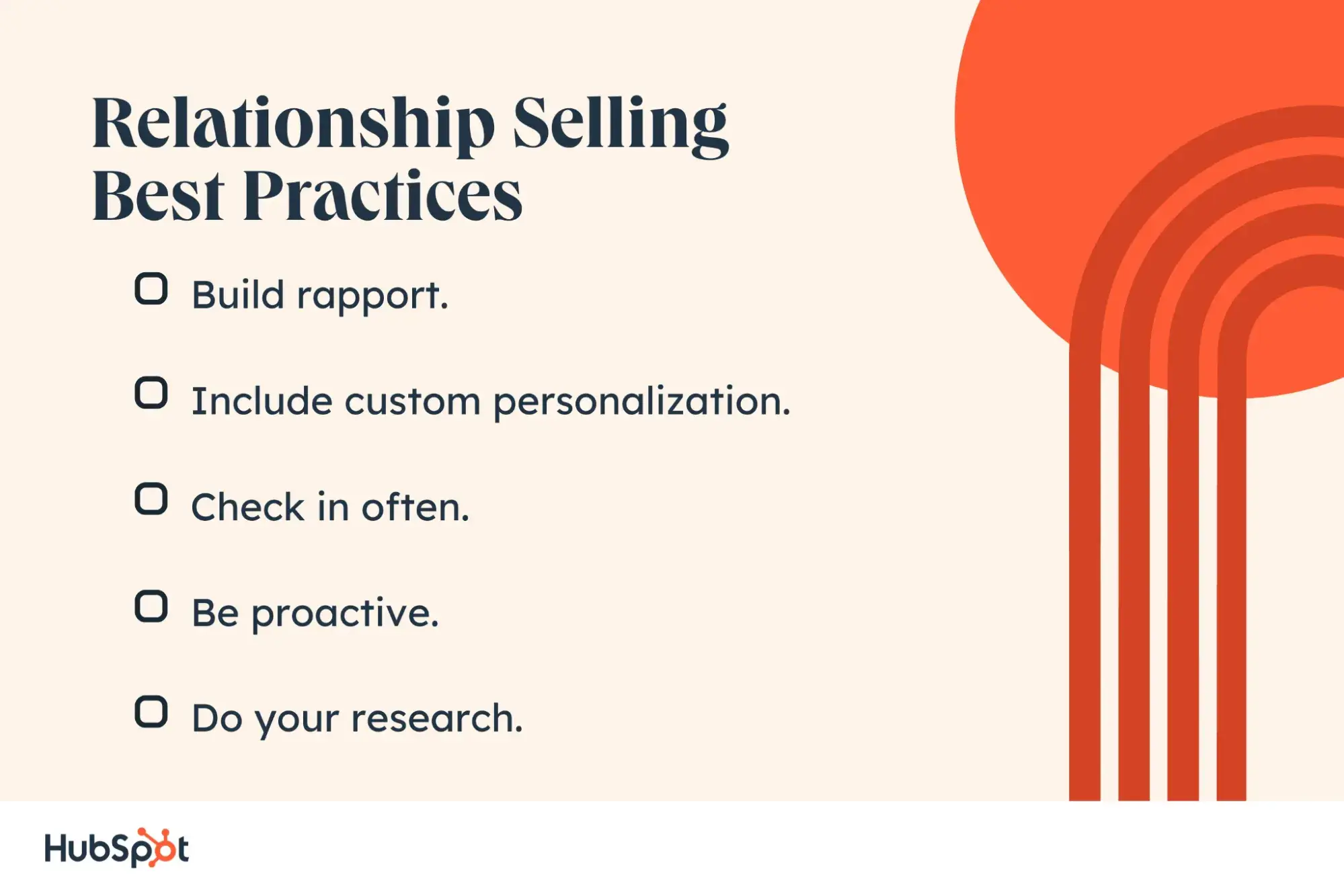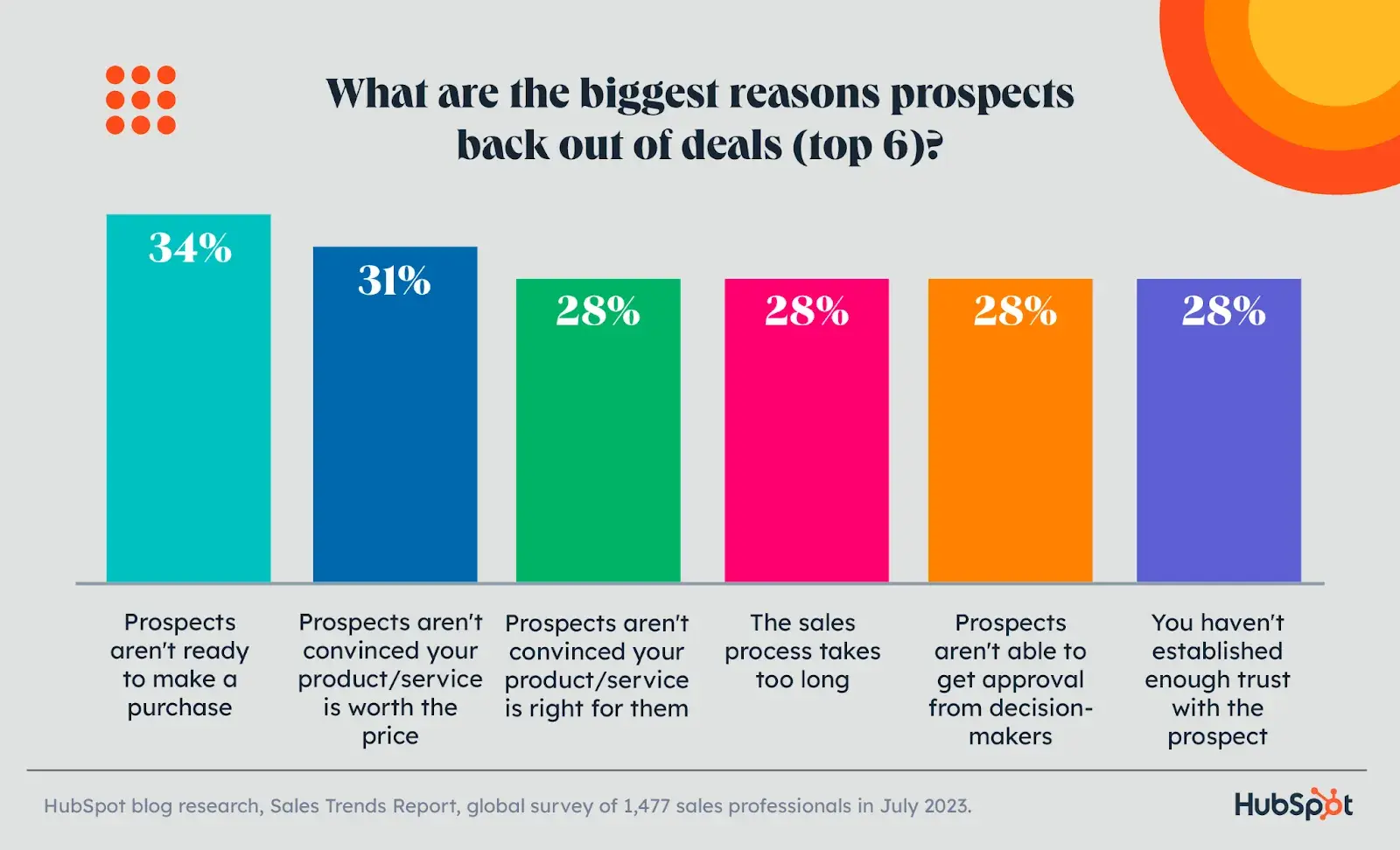Table of Contents
- What is relationship selling?
- Relationship Selling Process
- Best Practices for Relationship Selling
- Relationship Selling by Business Type
- Six Examples of Impactful Relationship Selling
- Incorporate Relationship Selling into Your Sales Process
What is relationship selling?
Relationship selling is a technique in which a sales rep prioritizes their connection with the customer over all other aspects of the sale. Think of it like forming relationships with friends. Friendships are built on trust, respect, and mutual understanding — usually by spending time together. Unlike other sales techniques, like transactional sales or needs-based selling where you immediately jump into customer pain points, relationship selling is all about creating genuine, meaningful relationships between your prospects and your brand before trying to close a deal.
Best Practices for Relationship Selling
In his book Relationship Selling, Jim Cathcart writes, “Relationship selling is a form of selling, not merely a type of relationship. The purpose of it is to help other people at a profit for you. When you are truly helping, you deserve to be well compensated for your product or service.”
I’ve found relationship selling to be an art, but it’s also a skill you can replicate by implementing tips from experts. Recently, I spoke with Chelsea Curtis, Director of Customer Success for Terra Dotta, to talk about best practices for relationship selling. She’s worked in sales for 20 years and has fine-tuned the art of building relationships.
However, she explicitly told me you don’t need 20 years of experience to become a pro at these kinds of sales. Instead, follow these best practices.

1. Embrace your network.
When I talked with Curtis, she pointed out that everyone could be a potential lead for your business — even the people you might not consider as decision makers for a brand. Some people might not be decision makers, but they can introduce you to those who are.
“Every single conversation has value,” she said. “The person you don‘t think is a decision maker? They might help you close a giant deal three years from now at a different company. The person at the front desk who isn’t worth talking to? Talk to them. You‘d be surprised at who they’d be willing to introduce you to — and which desk they may be sitting behind in six months.”
2. Build rapport.
As a former teacher, one of my key classroom skills was building rapport with my students. I’d make a point of spending the first few days of the new school year worrying less about starting the curriculum and instead focusing more on getting to know my students. This helped create deep, meaningful relationships because once I understood where my students were coming from, I could tailor my lessons to meet their needs.
Building rapport is also an essential step in relationship building. Creating connections between the rep and the buyer is emphasized more than the features or price of the offering. To build rapport, sales reps typically practice active listening to uncover prospects’ needs and form a successful relationship. They need to help meet these needs so they can provide value to the customer.
Considering that 72% of sales come from existing customers, it’s best to nurture these relationships for long-term success.
P.S. Looking for data-driven ways to build rapport with prospects and clients? Check out this blog post.
3. Include custom personalization.
To me, it shouldn’t be surprising to learn that 73% of consumers expect in-depth personalization. Personalization is an important facet of relationship-building. If they feel like the experience isn’t personalized, prospects are unlikely to purchase an expensive product. They’ll feel like they’re only part of a transaction and not part of a mutually beneficial relationship.

That’s why you’ll want to steer clear of transactional selling. It’s often quick and not personalized, which is why it’s fallen out of favor at most B2B organizations.
Don’t get me wrong, transactional selling works well for low-cost, commoditized products, where it doesn’t make sense for the rep to invest in getting to know their buyers. For example, the clothing and car industries partake in transactional selling.
Relationship selling is better for businesses where there’s a long sales cycle, and prospects need more touch points before making a purchasing decision. Overall, it’s good for high-cost situations and/or customized solutions, but those aren’t the only scenarios where it applies.
4. Don’t sell (kind of).
When I talked with Curtis, she compared sales to dating. Dating is much easier when you take a laid back approach and create genuine connections before jumping into a serious long-term relationship.
Sales is the same way. She told me,” Like dating, if you approach every date as a potential husband or wife, the date then becomes something filled with pressure, anxiety, and, often, disappointment. Instead, approach the “sale” as you would an interesting person sitting next to you on the bus or at a bar. Find out what motivates them, what challenges they‘re having, and why. It’s a conversation — and usually an interesting one at that. In doing so, you'll learn a lot more and close much faster.”
5. Check in often.
Just like it was important to check in regularly with my students, checking in frequently with your prospects is key to a relationship staying alive. Staying in touch with future and past customers ensures you’ll be the first person they think of when they need to buy or recommend your product.
Following up is an art, and the frequency you’ll want to check in may vary. I take pride in being nosey because polite nosiness lends well to building relationships. It’s okay to be politely nosey when you check in with your prospects. Ask about what’s happening in their life and share what’s going on in yours.
Connecting on a human level will lead to better communication in the future. Curtis agreed with me on this and said, “Be human. Go see people. It’s so much more fun and so much more effective.”
Curtis is on to something with getting out and meeting in person. 56% of sales reps say in-person meetings are effective. And, for strengthening relationships with your customers, that could mean a simple lunch meeting to check in. By checking in regularly without striking up a conversation about sales, you’re showing that you care about the person (and not just their wallets).
6. Be proactive.
If you’re running a promotion, have a new product, or are hosting a webinar, don’t wait for your prospects and customers to contact you. Proactively let them know of exciting developments at your organization.
In my experience, a little teaser of a new promotion or product release update can create just enough curiosity to draw your prospects to you. Just make sure the news is relevant and meets the needs of your prospects.
If you know their concerns, you can also work with product and marketing to develop solutions that will help them and other customers. Communicate across teams using Hubspot’s Account Based Marketing (ABM) software, so you can track and measure these customer relationships.
7. Do your research.
One of my favorite books is Dale Carnegie’s How to Win Friends and Influence People. I’m convinced this should be required reading for everyone in business. The principles in his book outline how to make genuine connections, including looking for common ground to connect with your prospect.
That means you might need to do some research to ensure your customers and prospects feel cared for. Before a call or email, be sure to check out their social media accounts to learn more about them. This can help open up meaningful conversations or give you ideas on how to show genuine interest and appreciation for their business.
8. Follow through.
Take it from me: If you want a relationship with your customers to last, you need to put in genuine effort. Being consistent with your actions and following through with your promises helps build your integrity.
When it comes to sales and a prospect trusting a brand with their money, integrity is essential — especially when you consider 28% of prospects back out of a deal because reps haven’t established enough trust.
Curtis gave a valuable piece of advice to protect integrity and gaining trust with your prospects. She said, “Integrity is everything. Guard it and protect it. Follow through when you say you will. Communicate consistently and clearly. Hold yourself accountable. Admit when you‘ve made a mistake. Be generous with your time with those you aren’t selling to.”
Relationship Selling by Business Type
You might think of relationship selling as an enterprise B2B strategy, and that’s certainly not wrong. I think it’s a safe bet to think that any rep working a $50,000+ deal is probably using relationship selling techniques — think a salesperson for sales automation software or a customized HR app.
But, relationship selling also applies to consumer products. How well do you know your tailor? If they’re smart, they’ll develop a personal relationship with you so your loyalty extends beyond their abilities. What about your favorite hairdresser? Mine keeps track of my favorite curly hair products and recommends new ones to try when she finds new products designed for my hair type.
Here are a few more examples where businesses use relationship selling.
Enterprise SaaS Companies
Enterprise SaaS providers (like us!) use relationship selling to sell their suite of products. In the first outreach email, the sales rep typically asks for a quick call, and as the nurturing process progresses, they send links to helpful materials and provide free demos.
These companies use a CRM to keep their prospects’ information on hand. That way, sales reps don’t need to recall customer details from memory, and the relationship develops seamlessly week after week.
Healthcare Providers
Healthcare providers use relationship selling, albeit in a different way than B2B businesses. My endocrinologist keeps notes on my likes, interests, and work history and then finds a way to work it into the conversation before jumping into why I’m visiting his office.
Plus, by keeping your medical information on hand, they can tailor your treatments depending on your needs. Even if you’re serviced by a different staff member, your experience remains consistent during each visit.
Subscription Services
In the B2C space, subscription services such as Spotify and Amazon Prime use deep algorithmic personalization to form a relationship with users. Spotify’s DJ X knows exactly what I need to hear and when I need to hear it. Even if you don’t speak to a salesperson, the platform examines your habits and serves you what you need so that you stay subscribed.
Another example would be Google. Raise your hand if you use Google for the seamless integration between each of its apps and services? My hand is fully in the air. The search engine examines your behavior to deliver personalized content and search results across all of its products.
Local Businesses
Local businesses such as nail salons, coffee shops, bakeries, and tailors (as mentioned above) use relationship selling to keep you coming back. For instance, if you’re a creature of habit like me, your nail tech might automatically reach for your favorite nail polish without thinking about it. They might also remember your name and details of your life to forge a personal connection.
The relationship selling process may look different depending on the industry, but no matter what, it’s composed of similar steps. Let’s take a look below.
Relationship Selling Process
- Provide value and insight in every email and phone call.
- Learn about your prospect’s challenges, objectives, and professional goals.
- Give advice that’s tailored to their business objectives.
- Solve for and empathize with your prospect’s objections.
- Find a win-win solution to the prospect’s objections.
- Keep providing value after the closed-won deal.
Six Examples of Impactful Relationship Selling
1. Provide value and insight in every email and phone call.
To quickly gain credibility and establish yourself as a trusted advisor, the very first thing you should do is provide value and insight to your prospect. That might mean reaching out with some helpful suggestions, sending them links to relevant content, making a valuable introduction, or anything else that benefits them.
I like this approach because instead of waiting to extract a sale, you can be helpful right out of the gate.
2. Learn about your prospect’s challenges, objectives, and professional goals.
Once you’ve gotten their attention and proved you’re worth their time, it’s time to get a nosey. Remember how I mentioned polite nosiness? Dig into their business challenges, objectives, metrics, and qualifying characteristics, along with their personal and professional goals. This information helps you answer two critical questions:
- Can your product help the prospect?
- Do they have the ability to buy it (authority, budget, appropriate timeline, etc.)?
These two questions cover the basics of sales qualification. Aside from ensuring the prospect is a good fit, it also helps you understand whether you can actually create a mutually beneficial relationship with them.
As much as I wish this was the case, not every prospect is your customer. Don’t force the sale with anyone who’s not a good fit. You might be able to convince them to buy, but remember: Relationship selling is about the long term. Your customers will be unhappy once they learn they’ve been misled, and you’ll face cancellations and/or returns rather than glowing reviews, referrals, upgrades, and cross-sales. And I don’t have to tell you what a massive blow that is to your reputation (and revenue!).
3. Give advice that’s tailored to their business objectives.
Going back to my teaching experience and building relationships in the classroom, I’ve found it is helpful to pay close attention to your prospects’ needs. Combining your new knowledge of the buyer with your subject-matter expertise will help you deliver better, more appropriate suggestions. For example, you might prescribe a strategy that’ll address one of their core pain points (and happens to align with your product).
I’ve also found it helpful to back up your recommendations with examples of customers who have been in similar situations. To give you an idea, you might say,
“Customer Y, another company with around [number] of employees in [X space], was facing a similar problem. I advised them to do [such and such]. In [period of time], they saw [quantified results].”
4. Solve for and empathize with your prospect’s objections.
Surfacing and solving your prospect’s blocking points is a necessary part of any sales process. I like to think of it as finding those hidden and not-so-hidden barriers and removing them. There are tons of reasons a buyer might be hesitant to make a purchase.
For example, 34% of buyers just aren’t ready, but that doesn’t mean you can’t convince them.

However, relationship selling calls for a careful approach. You never want to steamroll your clients — that’s guaranteed to turn them against you. Instead, give them ample time to explain themselves. Trust me when I say this: being patient and answering their questions honestly are critical aspects of relationship selling.
If your prospects have a genuine reason to be concerned, don’t ignore that. I guarantee your truthfulness will be more reassuring than a glib response (and will hold up after they get their hands on the product).
To identify the buyer’s worries, I suggest asking questions like:
- “Is there anything stopping you from buying?”
- “What are you anxious about?”
- “What do you wish was different about the product?”
Once they’ve answered, say:
“To make sure we’re on the same page, here’s what I got from that: [Paraphrase their objection]. Is that right? Did I miss anything?”
This proves you’re paying attention and truly care. Then show empathy with something along the lines of, “I hear what you’re saying, and that completely makes sense. Can I ask a few follow-up questions?”
Dig into the prospect’s objection to make sure you fully understand.
Finally, it’s time to respond. Don’t be combative — you and your prospect are on the same team.
5. Find a win-win solution to the prospect’s objections.
Many salespeople treat the negotiation like a zero-sum game. In other words, if the buyer wins, they lose, and vice versa. This mentality erodes trust and forces your negotiation partner to act selfishly. Plus, if they walk away feeling like you’ve taken advantage of them, your long-term relationship is doomed.
My solution? Change your thinking and act like a win for your prospect is a win for you. Together, you’re trying to find the best possible outcome.
To successfully respond to the prospect’s objections, here are my tips:
- Come prepared with several concessions you’re willing to make (like extra implementation help, better payment terms, the option to call you at any time for help, and so on).
- Proactively extend these compromises to show your prospect you’re on their side and make them more likely to extend concessions of their own.
6. Keep providing value after the closed-won deal.
Personally, I’ve never been a fan of a salesperson who disappears after the deal is done, especially if the purchase is a big one. For relationship selling to work, don’t disappear from the customer’s life as soon as they sign the contract — unless you want them to assume you’re only interested in their checkbook and not their success.
Instead, look for reasons to reach out every few months or every quarter, such as:
- An e-book, article, podcast, or other resources they’d be interested in.
- A company event you’d like to invite them to.
- A LinkedIn Pulse or blog post you’d like to feature them in.
- A follow-up to see how they like the product and if they have any questions or concerns.
- A "Congrats!” on a recent company or personal accomplishment.
- A “Happy Holidays” note.
Staying on their radar deepens the relationship and increases the likelihood they’ll stay a customer. And if they’re a big account and you have the budget, you may want to go even further:
- Take them out to dinner or a fun outing.
- Schedule a yearly, biannual, or quarterly account review.
- Send them tickets to a local performance.
- Invite them to tour your office.
- Coordinate a meeting between one of their executives and yours.
Incorporate Relationship Selling into Your Sales Process
Truthfully, I think the main principle of relationship selling is simple: Always think about the long-term impact of your actions. Here are several ways you can incorporate relationship-selling techniques into your sales process.

1. Be honest with your customers at all times.
I have always said honesty is the best policy — and that goes for business and sales, too. Dishonesty is kryptonite to business relationships. Make sure you’re never misleading your customers, either by giving them false information or withholding crucial details. You’ll earn their respect by telling them something isn’t right before they find out for themselves.
2. Consistently check in with your contacts and customers.
Be a continued presence for your clients. Interact with them on social media, send them value-added emails, and pay attention to the details of their personal lives so you can ask about their kids, past times, goals, etc.
3. Exceed your contact's expectations.
If you want to secure someone’s loyalty, blow past their expectations. To give you an idea, perhaps you told your contact you’d get them tickets to your annual industry event. And you do — but in addition to the tickets, you also arrange a private meet-and-greet with a speaker you know they look up to.
This extra surprise will exceed their expectations, and I guarantee this small act will bring them back to your brand time and time again.
4. Follow through on your commitments.
I know it sounds simple, but do your best to meet every due date and commitment. Maybe you said you’d send an email connecting them to your contact by Friday. It’s 6 p.m., and you know they’re not checking their inbox until Sunday morning — but that doesn’t mean you can wait. Every time you keep your word, you bolster your trustworthiness.
5. Provide exclusive perks.
Make your customers feel good. Tell them you’re grateful for their business, ask what you can do to make them happy, give them discounts, and, if possible, send them swag. Everyone loves being treated like they’re special.
Relationship Selling is the Better Way to Sell
If you’re like me and you’re not a natural salesman, sales can be tough. However, it’s important to remember that a sale isn’t a one-time transaction, but a relationship lasts long after the prospect signs on the dotted line.
With these techniques, you’ll build relationships with your customers that’ll allow you to cross-sell and upsell later without sacrificing the relationship. As a result, you’ll bring in more revenue, exceed quota, and shine as a top performer in your sales team.
Editor's note: This post was originally published on December 2017 and has been updated for comprehensiveness.
Sales Methodology






![I Learned How Sales Champions Drive Deals Forward — Here’s What You Should Know [+ Recent Data]](https://53.fs1.hubspotusercontent-na1.net/hubfs/53/sales-champion-1-20250110-9355712-1.webp)
![Decoding Buying Signals in Sales [+ Examples & What I Learned]](https://53.fs1.hubspotusercontent-na1.net/hubfs/53/buying-signals-1-20250501-3647992.webp)



-3.webp)
